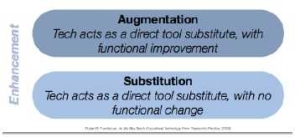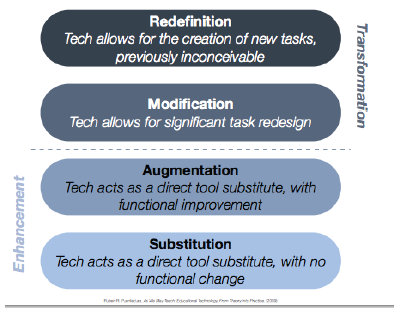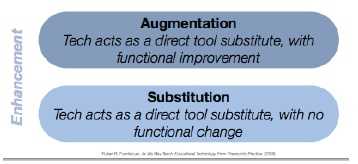When using the SAMR model, educators may gloss over some important points
 Lately, I have noticed a lot of talk about the SAMR model of technology integration. For those unfamiliar, SAMR is a framework for evaluating the level at which a given technology has had an impact on teaching and learning. The acronym stands for substitution, augmentation, modification, redefinition. It was designed by Dr. Ruben Puentedura to define the level of impact that a particular technology has on a learning activity. Each word in the acronym represents a higher level of impact.
Lately, I have noticed a lot of talk about the SAMR model of technology integration. For those unfamiliar, SAMR is a framework for evaluating the level at which a given technology has had an impact on teaching and learning. The acronym stands for substitution, augmentation, modification, redefinition. It was designed by Dr. Ruben Puentedura to define the level of impact that a particular technology has on a learning activity. Each word in the acronym represents a higher level of impact.
For example, in the substitution level, a technology replaces a more traditional tool with no functional improvement. A class that uses Google Docs to write their essays instead of a pen and paper is at the substitution level. In the augmentation level, the change brings about some amount of functional improvement such as a teacher embedding comments in the student’s Google Doc rather than passing pages back and forth. The modification level indicates a substantial redesign of the task. Perhaps now the teacher incorporates peer sharing and feedback from classmates. Finally, the redefinition level describes a task that would previously have been impossible to do without the aid of the technology, such as a project where student writing is published to the web—and open for outside feedback—through Google Docs.
There is definite value to looking at your use of technology through this lens. Essentially it is forcing a teacher to ask herself, “Is the technology adding value to what I am doing?”
As I have watched teachers at my own school attempt to use the SAMR model to both evaluate current uses of technology and to plan future ones, I have begun to identify a few big concerns.
Next page: Is redefinition always the goal?
[photo used courtesy of Dr. Ruben Puentedura]
 It’s easy to get hung up on the definitions. It isn’t hard to tell the difference between a use that is a simple substitution and one that is a redefinition. It is not always so easy to tell, however, whether a particular use of a collaborative tool is modification or merely augmentation.
It’s easy to get hung up on the definitions. It isn’t hard to tell the difference between a use that is a simple substitution and one that is a redefinition. It is not always so easy to tell, however, whether a particular use of a collaborative tool is modification or merely augmentation.
I firmly believe that it doesn’t much matter. For our purposes, I want our teachers to acknowledge that there are differences in the levels of impact and added value. It’s important to make sure that we are adding value, but getting hung up on exactly which category a use falls into is probably a waste of time. I like the fact that the SAMR model draws a dividing line between augmentation and modification. It defines uses that fall into the bottom two categories as “enhancement” and ones that fall into the top categories “redefinition.” It’s probably valuable for teachers to make sure that they have some activities on both sides of that line, but that’s about as granular as I want them to get.
It implies that redefinition is the ultimate goal. Advocates of the SAMR model will be quick to point out that redefinition is not inherently better than substitution or augmentation, but this point can’t be made often enough. Any model that places things in a hierarchy or an order is going to imply that the goal is to get to the top. I recently heard one metaphor that I really like that uses a swimming pool. There are lots of cool things to do in the deep end of the pool, and you want to make sure that everyone is comfortable enough to swim in the deep end. But there are plenty of fun (and important) things that can only be done in the shallow end. Teachers need to be comfortable swimming in both ends of the pool, but they should not be pressured into shoe-horning a “deep-end” activity into their curriculum because they think that is what is expected of them.
Most importantly, it says nothing about learning goals. My biggest concern about the use of SAMR to guide technology integration is that it focuses on how a learning activity has changed while saying nothing about how to determine the value of that change. In the hands of a talented teacher who has a clear sense of how her use of technology advances her goals for learning, this may not be a problem. When evaluating a school-wide program, however, I think it is critically important to identify specific learning outcomes to give some context and rationale for any change in learning activities. In our middle school iPad initiative, we identified three such curricular goals, and we said that uses of the iPad should be designed to help advance these three goals:
- Students should own their learning
- Students should consume information critically and intentionally
- Student should communicate clearly and powerfully.
While the SAMR model helps us to evaluate the magnitude of the changes brought about by our iPads, it is these three curricular goals that help guide us and ensure that such a change aligns with our stated goals about teaching and learning.
We use the SAMR model effectively to make sure that our teachers are all making use of both sides of the swimming pool where appropriate. It is important, however, to make sure we are also evaluating the ways that technology is helping us to advance our stated curricular objectives. To do this, we need to push beyond the SAMR model.
Trevor Shaw has worked as an ed-tech leader, speaker, writer, consultant, and classroom teacher for over 20 years. He is currently the director of technology at the Dwight-Englewood School and can be reached at @shawt, +TrevorShaw, and shawt at d-e.org.
- TC- What student choice and agency actually looks like - November 15, 2016
- What student choice and agency actually looks like - November 14, 2016
- App of the Week: Science sensor meets your smartphone - November 14, 2016


Comments are closed.